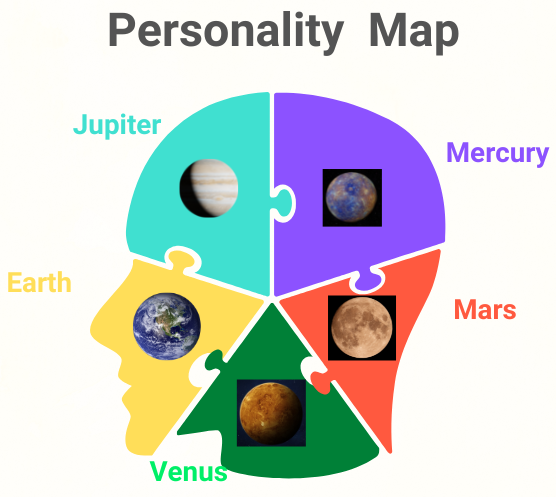Planet Phase Personality Inventory(PPPI) compared

BIG FIVE (OCEAN )
Personalities have been explained by the 5 factors of the Big Five, i.e., Openness, Conscientiousness, Extraversion, Agreeableness, and Neuroticism. While the Big Five, derived from the empirical study (factor analysis), does not explain personalities in terms of the combination of the five factors (OCEAN) which makes it difficult to apply in the real world. PPPI can explain and predict the direction of its dialectic movement.
ENNEAGRAM
Enneagram, despite its seemingly well-organized system, cannot capture the essence of human personality development except its well-designed classification. However, its practical usage is limited until we can explain how each of the nine personalities is formed and developed.
The following table describes each nine personalities of the Enneagram in relation to Planet Personality. As we will see, many personalities of the Enneagram describe one planet personality of the PPPI.
1. the Perfectionist (Mercury, Mars, Venus)
2. the Stoic (Mercury, Mars, Venus)
3. the Achiever (Mars)
4. the Individualist (Mars, Earth)
5. the Investigator (Mercury, Venus)
6. the Skeptic (Mercury)
7. the Enthusiast (Mercury, Jupiter)
8. the Challenger (Mercury, Mars)
9. the Peacemaker (Mercury, Venus, Jupiter)
The recent study (Hook, et al., 20021) found that “factor analytic work has typically found fewer than nine factors, and no work has used clustering techniques to derive the nine types.”
MBTI (16 Personality Test)
Many people know MBTI, but don’t realize it’s a simplified interpretation of Carl Jung’s original type theory. While MBTI became popular for good reason — it gives people a sense of self, a language to describe preferences, and a way to relate — it leaves out some of the most transformative elements of Jung’s work.
The Planet Phase Personality Inventory (PPPI) reintroduces Jung’s deeper vision. It integrates:
-
Archetypes and opposites
-
Object relations theory
-
Trauma-informed understanding
-
Developmental psychology
This post offers a comparison — not to diminish MBTI, but to invite those familiar with it to take a step further. If you’ve ever wondered why you feel stuck, change over time, or don’t quite fit your MBTI type anymore — PPPI may hold the answer.A popular personality test called MBTI uses Carl Jung’s original idea with 8 personality types: I, E, N, S, F, T, J, P along and their 24 combinations: IF, IS, IT, IN, IP, IJ, EF, ET, ES, EN, EP, EJ, NS, NF, NT, NJ, SF, ST, SJ, SP, FJ, FP, TJ, TP. There were originally 8 (IF, IS, EF, ET, ES, EN, IT, AND IN) included in Jung’s explanation.
Disproving the reliability and validity of MBTI,
Pittenger (1993) stated the Army Research Institute concluded that there is no evidence to support the use of the instrument for career planning counseling, therefore it should not be used for that purpose.
Another study (Gardner & Martinko, 1996) suggested more refinement needed to improve its effectiveness in measuring managerial attributes.
The data collected by reddit.com (2019) shows the majority (70%) of the test participants were clustered around personalities with the traits IN with sub-traits TJ, TP, FP, and FJ. The result does not explain the realistic distribution of the four personalities found by Gerlach et al.’s study (2018) which utilized four large data sets comprising more than 1.5 million U.S. and U.K. participants.
As I explained in other publications based on my research, human personalities can be explained through the developmental spectrum. It is at war with its subconscious counterpart, tending to change in the dialectic direction as they grow more conscious from the unconscious through life. The personalities they believe in having can be dynamic through dialectic or pendulum movement toward consciousness or maturity. For example, the measurement cannot be reliable without the emotional stage a person is at and the direction and momentum of their potential movement. Applying Jung’s theory, I can hypothesize that the personality of the next stage may be the dialectic realization of the inferior or shadow of the dominant personality in the prior stage. In other words, we need to consider the intensity of a particular personality in the developmental context, not as an inborn trait. Besides, as we mature, our extremely polarized tendency, for example, between introversion and extraversion, will converge into a more neutral or balanced personality.
Why PPPI May Feel More Accurate Over Time
Many MBTI users say:
“I used to be an ENFP… but now I feel more like an INFJ.”
PPPI explains this. You are not one static type. You evolve. Emotional defenses, trauma patterns, healing, and relationships all influence which planet phase you’re in.
You may start in Dark Mars, begin healing, and move into Bright Mars. Or swing between the two, like a pendulum — which PPPI fully expects and explains.
| Concept | MBTI | PPPI |
|---|---|---|
| Based on | Jung’s functions (simplified) | Jung + Object Relations + Trauma theory |
| Format | 16 types (e.g., INFP, ESTJ) | 5 Planets, 10 phases (e.g., Bright Mars, Dark Venus) |
| Core idea | Preference typing | Developmental emotional phase |
| Fixed or fluid? | Mostly static | Fluid and changeable over time |
| Trauma-aware? | ❌ No | ✅ Deeply integrated |
| Polarities? | ❌ Not directly addressed | ✅ Bright vs. Dark side of each phase |
| Life stage changes? | ❌ Ignored | ✅ Integral to understanding transitions |
